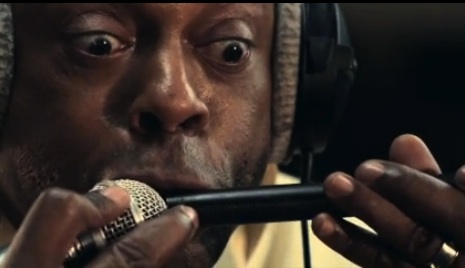The human typewriter
I’m passing along this video of actor Michael Winslow impersonating the history of the typewriter, which I got recently, as a subscriber to The Very Short List, which sends me a marvelous daily email about imaginative little gems in the vast ocean of the Web. (Sadly, though I get interesting alerts to books, movies and music, the visual arts seem underrepresented there, as they so often are as a subject of interest to your average Web surfer.) Winslow had a role in Police Academy as Larvell “Motor Mouth” Jones. Here he seems somehow to have physically assimilated an entire sequence of typewriters into his body, so that when he creates the sound of someone typing tentatively on one of them, he looks like a man possessed and the effect is beyond uncanny. It’s a little chilling and, eventually, inspiring. At the beginning of the video, Winslow looks as if he’s gathering all his inner ch’i, eyes closed, solar plexus locked into a crunch, to actually imprint words on paper with nothing but the sound emerging from his lips. You find yourself forgetting everything else that ought to be commanding your attention and listening to the magic of keys hitting paper on platen, followed by the incredible scriiiick of the carriage return. It’s a different set of sounds with every single typewriter he imitates. It’s as if he’s been close friends with each one of these machines for half his life. I wonder if most people who click to this video have even heard a typewriter being used, much less an old manual one, except in the movies, but if you have, you’ll agree this little performance is a wonder of mimesis. There’s an element of reverent nostalgia in all this for me, because I miss typewriters, the terrible sense of commitment to each word they entailed with all that heavy impact that could leave a little image of each letter in a sort of braille on the reverse side of the paper. (I mean terrible because who wanted to pick up one of those little eraser wheels with the stiff black bristles on one end and put that to use? Oh, and then came salvation for those of us challenged in the work ethic department, the “correcting Selectric” with the sticky tape that would lift errant words right back off the paper.) Woody Allen has used the same ancient manual typewriter to commit everything he’s ever written to paper, and he gets around the problem of erasers by actually cutting and pasting rectangles of new paper, with new words, over the old ones–as he demonstrated in the recent PBS biography of him. Winslow conveys a lot of that slow, deliberate sense of one-hard-word-after-another in the pace of his imitation, and his imaginary words emerge into the air with the random cadence of corn just starting to pop.
I’m offering this little video because it brought to mind, for me, two things. One was the sensation I got when I first read Nicholson Baker’s The Mezzanine, which I’ve mentioned before here–the way in which he could take the most ordinary details of a routine lunch break and render them fascinating by bringing a new level of microscopic focus and attention to them. It also reminded me of the sensation of looking at an incredibly detailed painting and how it can create a thirst to see more simply by presenting assiduously rendered details, which have no conceptual value or worth, but, because they’ve been brooded upon for hours or days or weeks by an artist, seem to shine with an original kind of interest and value. Recently, Derek Wilkinson’s self-portrait at Manifest, had this effect: it made me marvel at the complexity of color in human skin, seeming to capture the way light reflects off the surface, but also at deeper layers, where the colors deepen and change hue. Representational painting is, in varying degrees, an act of mimesis akin to what Winslow does here, and at its best, it makes you want to return to the world and just look or listen, and be more intensely aware of whatever is simply there. The downside for me in all of this is that now I want to help revive the economy by spending money I don’t have on this.

Comments are currently closed.